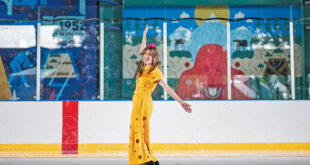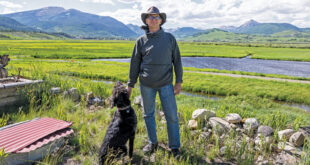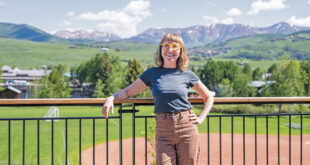Fay Vader is tall and lean with a wizened smile under her western hat that tells of a lifetime of ranching and riding. At 81 years of age, she has more spunk than many half her age. And she’s still riding.
Born in Powderhorn, Vader was the last of the 11 children of Helen and Jeff Phelps. Her older sisters were grown and married by the time she came along and she was only three when the family moved to their Gunnison ranch just down the road from McCabe’s Lane.
“It was a rough life but I didn’t know the difference. I enjoyed it,” she says of simpler times. “We raised and butchered our own beef and we had pigs and chickens. My mother canned a lot of that meat. We didn’t have a freezer. We didn’t have a refrigerator. We had an icebox. My dad and older brothers would go out in the winters and cut ice off the river in great, big, huge chunks. We had an icehouse that would keep the ice frozen through the summer. They’d bring the big chunks in, cover those in sawdust and it would last through August. It either kinda melted by then or we ran out. I can remember being sent down to get ice for tea,” she recalls.
Vader started school at Blackstock Elementary and went through the Gunnison school system back when the high school and junior high were in the same building, until she graduated in 1951.
“Times were hard in those days,” Vader points out. “There were a lot of unemployed. They would come to our house because they had nothing to eat. They only had what was on their backs. Mom would feed them and Dad would make them chop a little wood for their meals and let them sleep in the barn,” she says of her parents’ kindness.
Her father would search each of them though for matches and cigarettes before he let them into the barn and Fay recalls, “If he found them, he’d take [the matches and cigarettes] away because [the men] were sleeping in our hay loft and there’d be the biggest fire you ever saw if something happened.”
Some of Vader’s vivid memories revolve around dramatic incidents like an enormous, building-sized stack of hay catching on fire and a close call for her brother Lawrence. “It was on the very last load. The bottom of the cable on the overshot stacker got hot and set the stack on fire and the loose hay just exploded. It could have been worse… my brother Lawrence was on top and he ran to the back of the stack and jumped into another stack of hay that a hired man had pushed up so he could jump off. That haystack burned for two or three days. It just smoldered.”
In another ranch incident, the horse teams bolted in what was nearly a stampede. “We once had runaway horse teams during haying; it was kinda scary.” Fay explains that after the work season was done the horses were left on their own to run through the hills until January or until the snows got too deep that they couldn’t survive, so they were somewhat wild.
“We had great horses. They only got work during haying and in those days we started haying later, about a month later than now, during the last of July. There were six or seven teams and they all ran away, pulling the rakes or buck rakes behind them.”
Brow raised, Fay describes how the horses were spooked by a guy on a horse who came up behind them. “Every team in the field ran. It injured several of the hay men. All the horses ran across the road, back to the barn, destroying the rakes.” Vader describes the splintered equipment strewn across field and road and remembers that it took quite a while to get that machinery together so they could start haying again. “That’s the way it was in the olden days,” she says.
Back when trains were still a vital part of the valley, Vader would help Lawrence drive the cows to load them up on the cars out of Iola, where the dam is now. All the men would then go to Denver to sell the cattle and the women would take all the horses home. Vader smiles remembering that her brother, bored, would get out and walk alongside of the train as it went so slowly up old Monarch Pass.
Fay married Harry Vader in 1951 and notes, “Then I had a ranch and I went to ride the ranges. I rode almost every range in Gunnison except Mill Creek. I rode for all the ranchers. They’d call me whenever they needed somebody to help move cattle. I helped everybody move cows. I drove a team for haying. I hated when they changed to tractors—they smell and they’re noisy. I liked my teams better but you gotta change with the times. The changes are okay, I guess, but I just don’t like change. When you get to be my age you want it to be the same.”
Back in those younger days, Vader participated in 4-H and helped to start the Brush Poppers. “We had a drill team called the Helldorado Girls, a women’s drill team and we went out and performed drills during Cattlemen’s Days. It’s sort of a coordinated marching with horses. It was very popular in those days. People would come from as far away as New York just to see a bunch of women riding. I was 11 when I started and it went on for years. We didn’t have horse trailers in those days. We rode them to the show.”
Her favorite Cattlemen’s Days event? Bull riding, of course. “I did some rodeo,” she smiles and explains that one of the events she participated in was called pole bending or stake racing. Stake racing was basically the same thing as barrel racing. “I did trick riding at Cattlemen’s. Trick riding… it’s what stupid people do,” she chuckles. “You ride upside down hanging and get your head kicked by the horse. You either stand straight up or side drag, hanging down the side of your horse by one leg and ride back and forth in front of the grandstand. A lot of people call that stunt riding but I think it should be called trick riding. In the movies it’s called stunt riding… stuff like getting dragged by your stirrup.”
Fay should know about stunt riding. She was told that she was one of only three women in the film industry who stunt doubled on horses in the 1950s.
“Making movies is terribly boring. You had to wait for the light, wait for the sun.” Fay wasn’t the Hollywood type but she recalls, “I really had those men where I wanted them. They didn’t like having to dress up as women and ride so when I said jump, they said how high,” she laughs and her eyes gleam like the cat that got that mouse.
There were virtually no female stunt riders back in 1950. Fay was experienced as a ranch hand and trained herself and her horse for trick riding. “I was about 17 and we went to visit friends in Lake City. We found out they were making a movie that was being shot at the VC Bar Ranch there. It was right after the rodeo, and we went up to watch them film Caribou Trail. The guy asked me if I knew how to ride and I said, ‘Yeah, kind of,’ and they put to me to work that very day. They loved me to death. I could ask them to jump off a cliff and they’d say ‘Yes, Ma’am,’” she grins.
Working on her second movie project, which involved the winter scenes during the filming of The Searchers, Fay found herself up Mill Creek and on the Cooper Ranch on the Gunnison River for the water scene. “We were dressed as Native Americans and we had to jump from an I-shelf that was about six feet tall into the frozen Gunnison River. Those days we had a lot of ice and all morning they spent dynamiting a hole so we could jump our horses into it. It didn’t get above 25 degrees below zero. The stunt men would test the hole—they would send us across the ice and have us jump into the hole.” She noticed that each time they shot the scene, the returning stunt men would be fewer. “And they made more money than I did, too!”
Fay did a lot of “wild riding,” as she calls it. “Being chased by bandits, they weren’t really stunts, but pretty wild scenes with our horses, like jumping over cliffs. I got paid really well. I think I got $100 a day and in those days that was a big bunch of money. They had me do a screen test and they wanted me to go to California. They thought I was going to be the next Jane Russell,” she giggles. “They wanted me to be a double for her too but I didn’t want to be a movie star.”
She speaks fondly about some of her horses of the past that have gone on to graze in greener pastures. Her favorite was her trick horse, Velvet, a wild horse right off the range. “She was the best horse ever. Bob Reese owned her and wanted $35 for her and I thought that was a lot of money,” which, Fay says, it was in the early 1950s. “I thought about it and finally I bought her. She didn’t do anything wrong or make a mistake in her whole life.”
Today she has only one horse left, a once-ornery half-Arabian that is now a respectable 32 years old and far too old to ride. Fay shakes her head, smiles, and confesses that she’s seriously considering getting another horse. But that’s what real cowgirls, used to working hard all their lives, do… they keep riding.
 The Crested Butte News Serving the Gunnison Valley since 1999
The Crested Butte News Serving the Gunnison Valley since 1999




